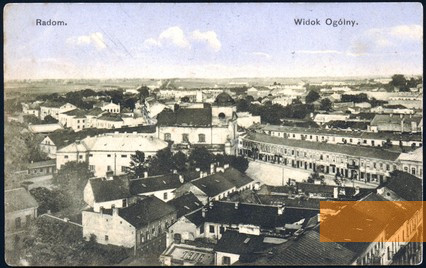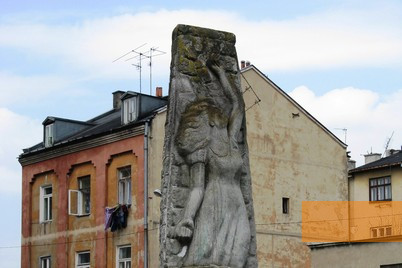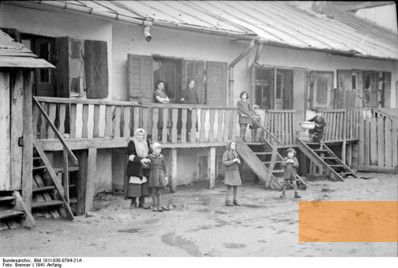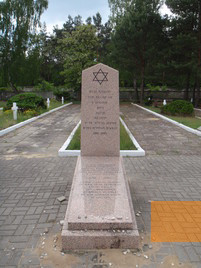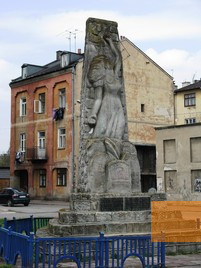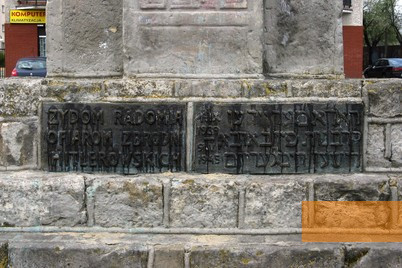Only a few hundred Jews of Radom survived the Holocaust. Today there is little to remind us of the town's Jewish inhabitants who made up almost one third of the population prior to the Second World War.
Prior to the Second World War almost one third of the 85,000 inhabitants of Radom, a town in central Poland about 100 km south of the capital Warsaw, were Jewish. The first Jews settled in Radom presumably in the 16th century but only since 1850 the Jewish community grew rapidly. The Jews of Radom were comparatively unassimilated, among themselves they mainly spoke Yiddish. Centre of their religious and cultural life was the synagogue built in 1844.
The German Wehrmacht conquered Radom in September 8, 1939. In the followings months the town had to accommodate many thousands of Jews, deported by the German administration from around Poznań, a region which was immediately annexed by Germany. In the course of the year 1940 thousands of Jews were deported from Radom to labour camps, many of them were murdered.
In April 1941 the German administration set up two ghettos: a large one for approximately 25,000 Jews in the town centre and a small one in the suburb of Glinice, which about 8,000 Jews were confined to. The living conditions in both ghettos were catastrophic, the population, crammed into a very confined area, was starving. In the following months the SS carried out »actions« in both of the ghettos where many Jews were shot dead or deported to camps. In August both ghettos were dissolved after each other with utmost brutality. Hundreds of Jews, above all elderly and children and those who tried to offer resistance or tried to hide, were murdered on the spot. All in all the SS deported approximately 24,000 Jews to the extermination camp of Treblinka, where they were murdered upon their arrival by poison gas. About 4,800 men and women were assigned for forced labour, only very few of them survived to see the end of war.
The German Wehrmacht conquered Radom in September 8, 1939. In the followings months the town had to accommodate many thousands of Jews, deported by the German administration from around Poznań, a region which was immediately annexed by Germany. In the course of the year 1940 thousands of Jews were deported from Radom to labour camps, many of them were murdered.
In April 1941 the German administration set up two ghettos: a large one for approximately 25,000 Jews in the town centre and a small one in the suburb of Glinice, which about 8,000 Jews were confined to. The living conditions in both ghettos were catastrophic, the population, crammed into a very confined area, was starving. In the following months the SS carried out »actions« in both of the ghettos where many Jews were shot dead or deported to camps. In August both ghettos were dissolved after each other with utmost brutality. Hundreds of Jews, above all elderly and children and those who tried to offer resistance or tried to hide, were murdered on the spot. All in all the SS deported approximately 24,000 Jews to the extermination camp of Treblinka, where they were murdered upon their arrival by poison gas. About 4,800 men and women were assigned for forced labour, only very few of them survived to see the end of war.
Of the approximately 30,000 Jews living in Radom immediately after the occupation by the German Wehrmacht only a few hundred survived the Holocaust. The SS murdered most of the Radom Jews in the gas chambers of the Treblinka extermination camp in August 1942: 6,000 from the small and 18,000 from the large ghetto. Thousands more were shot during various »actions«, many died in the ghettos and work camps of starvation and diseases.
After the war about 400 Jews returned to Radom, however, they left the town shortly afterwards. The Jewish community was active until 1951, in 1965 the town's Jewish population was down to seven. Today there is little to remind of the once thriving Jewish life in Radom. The best known memorial is the »Memorial to the Jews of Radom« erected in 1950 on the site of the synagogue from 1844. The Polish and Hebrew inscription on it reads: »To the Jews or Radom – victims of Nazi crimes«.
In the suburb of Firlej the SS murdered more than 15,000 people during mass shootings, apart from Jews also Polish intellectuals, freedom fighters and civilians. Since October of 201 there is a separate memorial to the Jewish victims. Another site of remembrance is the seemingly abandoned Jewish cemetery.
In the suburb of Firlej the SS murdered more than 15,000 people during mass shootings, apart from Jews also Polish intellectuals, freedom fighters and civilians. Since October of 201 there is a separate memorial to the Jewish victims. Another site of remembrance is the seemingly abandoned Jewish cemetery.
- Name
- Pamięci Radomskich Żydów
- Address
-
Bóżniczna / Podwalna
26-600 Radom - Open
- The memorials are accessible at all times.


